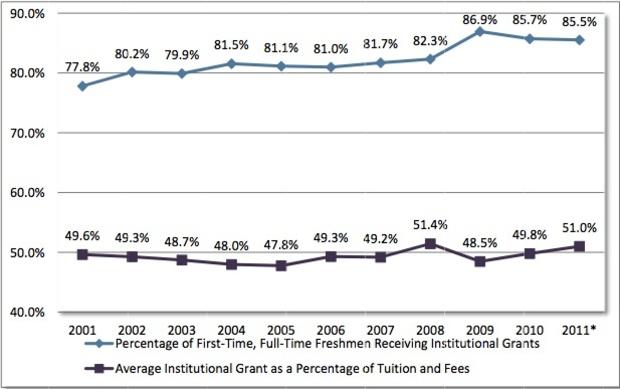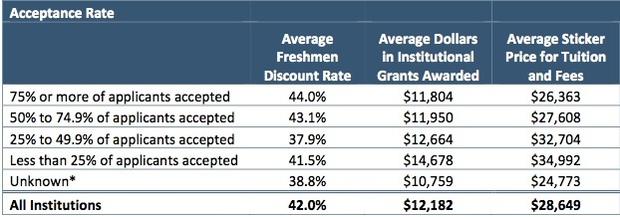Cutting the price of college by more than half
(MoneyWatch) College price tags are meaningless.
For most students, the price they pay for a bachelor's degree will be lower than the sticker price.
The latest evidence of this reality comes from the National Association of College and University Business Officers. In its annual survey of private colleges and universities, the association concluded that the typical freshman receives a price break of 51 percent off his or her tuition through grants and scholarships.
For example, with a 51 percent discount, a student would pay $17,150 for a school that charges $35,000 for its tuition. These price breaks, by the way, are not just reserved for overachieving braniacs. Among the 400 private institutions surveyed, 85.5 percent of freshman received one.
Private institutions have been offering healthy price breaks to their applicants for many years, as the chart from the NACUBO shows below. The percentage of students who have captured institutional scholarships increased from 77.8 percent in 2001 to 85.5 percent in 2011. The biggest year for generous aid packages was in 2008 when the stock market tanked and the recession wreaked havoc.
More selective schools are less likely to slash prices than institutions that accept the vast majority of their applicants. Popular higher-ed destinations don't have to work as hard to attract students, so they don't need to offer attractive scholarships to fill their freshman classes. In fact, the most prestigious schools -- those with high college ratings from US News & World Report -- don't give non-need-based scholarships at all. In other words, rich
students have to pay full price at elite schools like Harvard and Williams
College.
Schools that don't enjoy great brand names, however, often have to kick in more money to attract students. These institutions give money to teenagers who need financial aid as well as those who don't. According to the survey, 73 percent of all the grants were directed to students who required financial aid.
In the following chart from the NACUBO, you can see that the discount rate is highest for schools that are the least selective.
Discounts on tuition prices are not a new phenomenon in the higher-ed world, but the size of the discounts this year didn't work their magic. Nearly half of private institutions reported experiencing no growth in enrollment or a decline. The problem was particularly acute at non-selective small colleges.
For some of these schools, the austerity measures that they implemented back in 2008 aren't going away anytime soon.
Bottom line: How can you tell if a school will provide your child with a discount? It's simple. Use the institution's net price calculator that's required to be posted on its website.


